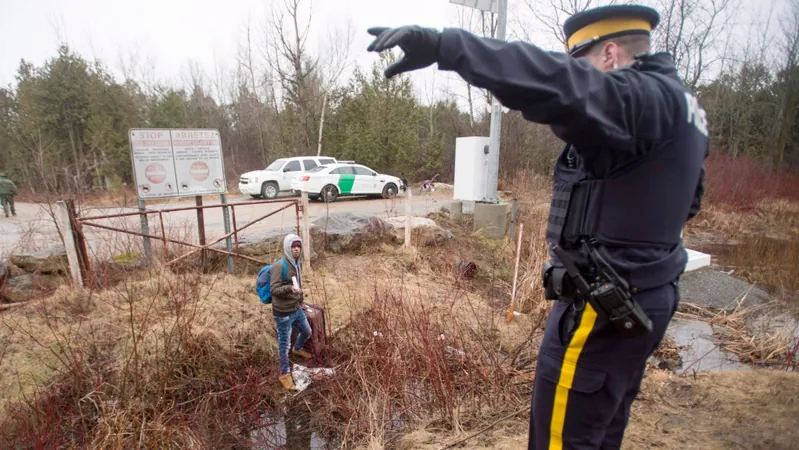
RCMP Braces for Influx of Migrants as Trump Takes Office Again – What You Need to Know!
2024-11-07
Author: William
As Donald Trump returns to the presidency, Canada's federal police force, the Royal Canadian Mounted Police (RCMP), is ramping up its readiness for a potential surge of migrants at the Canada-U.S. border.
This follows Trump’s campaign promises to pursue aggressive immigration enforcement, including plans for mass deportations that could leave many in the U.S. feeling vulnerable and desperate to seek refuge in Canada.
Are Canadians Ready? The Resource Challenges at the Border
One of the significant concerns is whether Canadian authorities have the capacity to manage a large influx of migrants. The Customs and Immigration Union has sounded alarms, indicating a pressing need for an additional 2,000 to 3,000 officers to effectively respond to potential border pressures.
With current staffing levels stretched, union representatives stress that the government must ensure adequate resources are in place should the need arise.
RCMP spokesperson Sgt. Charles Poirier has outlined plans that include increasing officer deployment along the approximately 800-kilometer Quebec-U.S. border and bolstering resources such as temporary holding facilities and police vehicles. This fortification aims to prepare for various scenarios, including the worst-case likelihood of a mass arrival of asylum seekers.
Historical Context: What Happened After Trump's First Election?
Reflecting on the past, following Trump’s initial election in 2016, Canada witnessed a notable surge of asylum seekers, particularly at Roxham Road in Quebec. A loophole in the Safe Third Country Agreement allowed many to enter Canada illegally.
Although modifications to the agreement in 2022 have since limited this route, many would-be asylum seekers still feel the need to cross the border without prior notice.
Legal experts, like immigration lawyer Richard Kurland, have forecasted that Trump's renewed immigration policies could precipitate what he describes as a "tsunami of refugee claims." Many who fear deportation in the U.S. might see Canada as their only refuge, thus placing significant pressure on Canada’s refugee determination system, already criticized for its lengthy processing times.
Government's Response and Reassurances
Meanwhile, Quebec Premier François Legault is urging the federal government to act swiftly to ensure adequate staffing at the border, emphasizing the need to monitor and control immigration numbers closely.
Prime Minister Justin Trudeau has responded by reinstating a special cabinet committee to address Canada-U.S. relations and the immigration challenges that could arise.
Public Safety Minister Dominic LeBlanc has expressed confidence in the planning efforts undertaken by the RCMP and the Canadian Border Services Agency. He reassured Canadians that the government is prepared for contingencies while cautioning against undue alarm regarding migrants crossing the border.
Insights from Refugee Organizations
Non-profit organizations working with asylum seekers are also weighing in on the situation. Abdulla Daoud from Montreal’s Refugee Centre, while recognizing that there may be an increase in applicants, suggests that it will likely unfold gradually rather than as an immediate crisis.
The organization cautions against sensationalizing the issue, suggesting that other migration patterns, especially from regions outside the U.S., may complicate the landscape.
Dangerous Crossings and Public Safety Concerns
The RCMP's proactive measures come in the wake of tragic past incidents where desperate individuals attempting to cross the border met perilous outcomes, including hypothermia and fatalities.
Sgt. Poirier has stressed that crossing into Canada is neither easy nor safe, particularly when relying on the services of human smugglers who may misrepresent the dangers involved.
As Canada braces itself for what many suggest could be a consequential shift in its immigration landscape, authorities are committed to navigating this complex humanitarian challenge while prioritizing safety and resource management on the front lines.









 Brasil (PT)
Brasil (PT)
 Canada (EN)
Canada (EN)
 Chile (ES)
Chile (ES)
 España (ES)
España (ES)
 France (FR)
France (FR)
 Hong Kong (EN)
Hong Kong (EN)
 Italia (IT)
Italia (IT)
 日本 (JA)
日本 (JA)
 Magyarország (HU)
Magyarország (HU)
 Norge (NO)
Norge (NO)
 Polska (PL)
Polska (PL)
 Schweiz (DE)
Schweiz (DE)
 Singapore (EN)
Singapore (EN)
 Sverige (SV)
Sverige (SV)
 Suomi (FI)
Suomi (FI)
 Türkiye (TR)
Türkiye (TR)